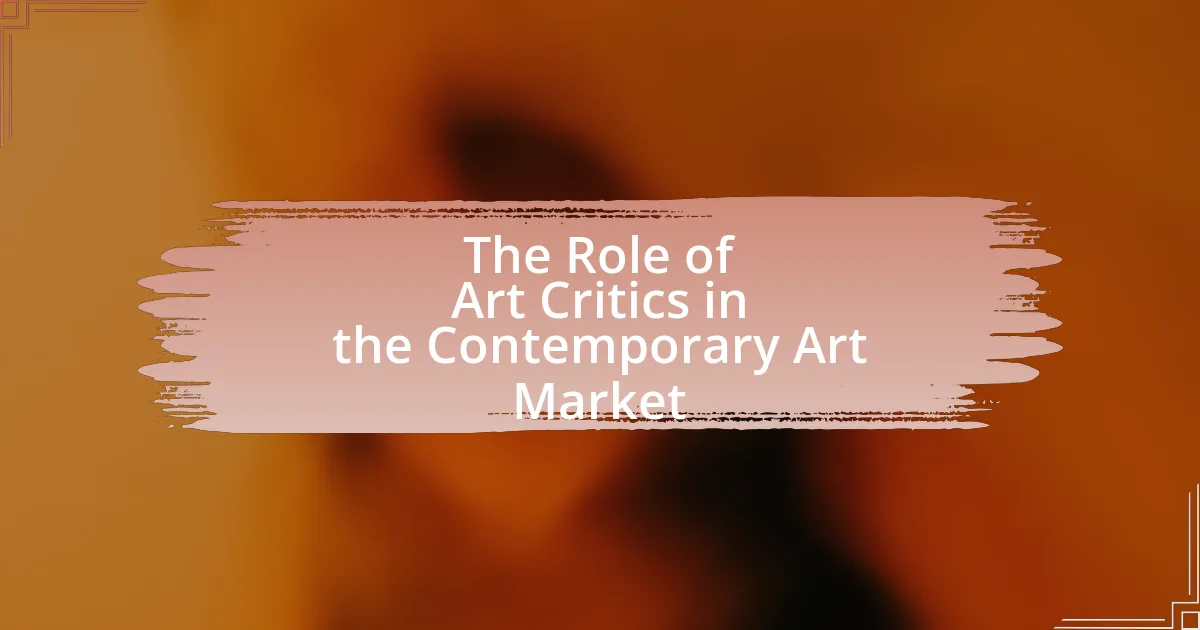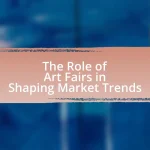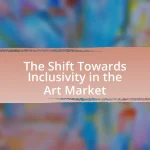Art critics play a vital role in the contemporary art market by analyzing, interpreting, and evaluating artworks, which significantly influences public perception and market value. Their critiques shape narratives around artists and exhibitions, guiding collectors and galleries in their decisions. The article explores how art critics impact the perception of contemporary art, the methods they use for evaluation, and the challenges they face in a rapidly evolving market. It also discusses the influence of social media on art criticism, the importance of inclusivity, and the skills necessary for future critics to succeed in this dynamic landscape.
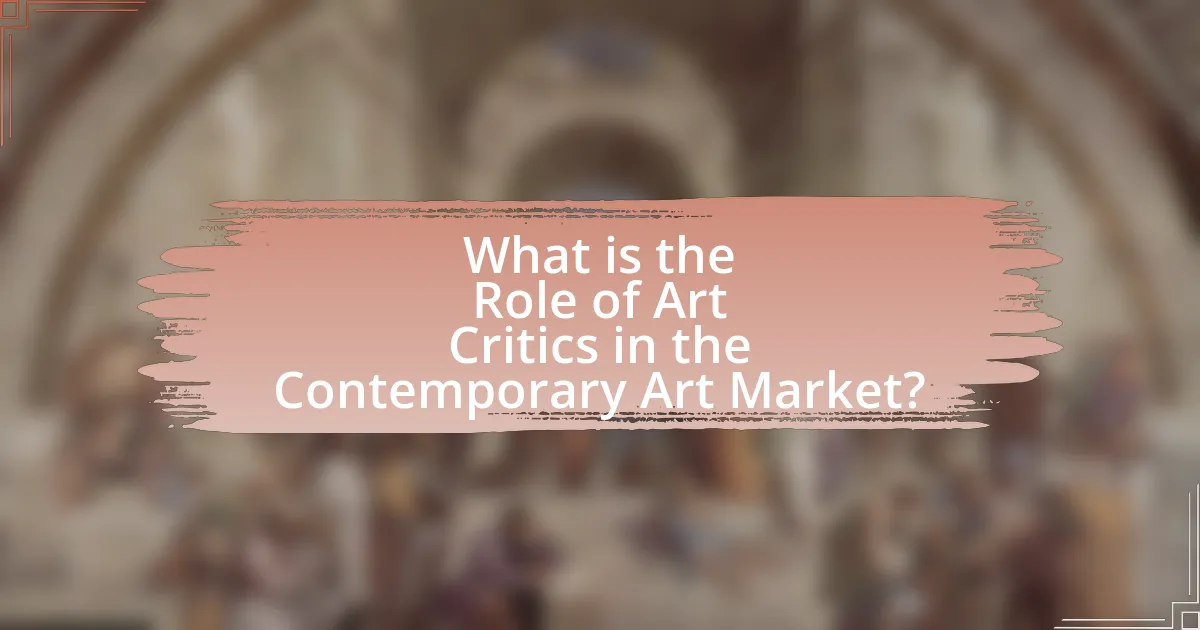
What is the Role of Art Critics in the Contemporary Art Market?
Art critics play a crucial role in the contemporary art market by providing analysis, interpretation, and evaluation of artworks, which influences public perception and market value. Their reviews and critiques help shape the narratives around artists and exhibitions, guiding collectors, galleries, and institutions in their decisions. For instance, positive reviews from reputable critics can significantly increase an artist’s visibility and desirability, often leading to higher sales and auction prices. According to a study published in the Journal of Cultural Economics, art critics’ evaluations can impact the financial success of artworks, demonstrating their importance in the economic dynamics of the art market.
How do art critics influence the perception of contemporary art?
Art critics significantly influence the perception of contemporary art by shaping public discourse and providing interpretative frameworks. Their reviews and critiques often determine which artworks gain visibility and credibility, impacting artists’ reputations and market value. For instance, a positive review in a prominent publication can elevate an artist’s status, while negative criticism can diminish it. This dynamic is evident in the way critics highlight specific themes, techniques, or cultural contexts, guiding audiences’ understanding and appreciation of contemporary works. Furthermore, critics often serve as gatekeepers, influencing which exhibitions receive attention and which artists are promoted, thereby directly affecting the contemporary art market.
What methods do art critics use to evaluate artworks?
Art critics use a variety of methods to evaluate artworks, including formal analysis, contextual analysis, and comparative analysis. Formal analysis involves examining the visual elements of an artwork, such as composition, color, line, and texture, to assess its aesthetic qualities. Contextual analysis considers the historical, cultural, and social contexts in which the artwork was created, providing insight into its significance and meaning. Comparative analysis involves comparing the artwork to other works by the same artist or within the same genre, allowing critics to evaluate its originality and impact. These methods are grounded in established art theory and criticism, which provide a framework for understanding and interpreting art.
How does the language of art criticism shape public understanding?
The language of art criticism shapes public understanding by providing a framework for interpreting and evaluating artworks. This specialized vocabulary and analytical approach help demystify complex artistic concepts, making them accessible to a broader audience. For instance, art critics often employ descriptive language and contextual analysis to articulate the significance of a piece, which can influence public perception and appreciation. Research indicates that art criticism can enhance viewer engagement and foster a deeper connection with art, as seen in studies that show increased attendance at exhibitions following critical acclaim. Thus, the language used in art criticism plays a crucial role in guiding public discourse and shaping cultural narratives around art.
Why are art critics considered essential in the contemporary art ecosystem?
Art critics are considered essential in the contemporary art ecosystem because they provide informed analysis and interpretation of artworks, which helps to shape public perception and understanding of art. Their critiques often influence market trends, as collectors and institutions rely on their insights to make purchasing decisions. For instance, a positive review from a respected critic can significantly increase an artist’s visibility and market value, as seen with artists like Jeff Koons and Damien Hirst, whose careers were bolstered by critical acclaim. Additionally, art critics contribute to the discourse surrounding art, fostering dialogue and engagement within the community, which is vital for the growth and evolution of contemporary art.
What impact do art critics have on artists and their careers?
Art critics significantly influence artists and their careers by shaping public perception and market value. Their reviews can elevate an artist’s profile, leading to increased visibility and opportunities for exhibitions and sales. For instance, a positive critique in a prominent publication can result in a surge of interest from collectors and galleries, as seen when critics like Jerry Saltz have propelled lesser-known artists into the spotlight. Conversely, negative reviews can hinder an artist’s career by damaging their reputation and limiting their access to opportunities. The impact of art critics is evident in the way they can either validate an artist’s work or challenge its significance, ultimately affecting the trajectory of the artist’s career in the contemporary art market.
How do art critics contribute to the value of artworks in the market?
Art critics significantly enhance the value of artworks in the market by providing informed evaluations and contextual analyses that influence public perception and collector interest. Their reviews and critiques often shape the narrative surrounding an artist’s work, establishing a reputation that can lead to increased demand and higher prices. For instance, when a critic highlights the innovative aspects of a piece or situates it within broader art movements, it can elevate the artwork’s status, as seen in the case of artists like Jeff Koons, whose market value surged following critical acclaim. This relationship between critical reception and market value is evidenced by auction results, where works by highly praised artists often fetch significantly higher prices compared to those with little or no critical recognition.
What challenges do art critics face in the contemporary art market?
Art critics face several challenges in the contemporary art market, primarily including the rapid evolution of art trends, the influence of social media, and the commercialization of art. The fast-paced nature of contemporary art means critics must constantly adapt to new styles and movements, which can lead to difficulties in maintaining expertise and relevance. Additionally, social media platforms have democratized art criticism, allowing anyone to share opinions, which can dilute the authority of established critics and complicate the landscape of art evaluation. Furthermore, the increasing commercialization of art often prioritizes marketability over artistic merit, making it challenging for critics to uphold standards of quality and integrity in their assessments. These factors collectively create a complex environment for art critics, impacting their ability to effectively analyze and critique contemporary works.
How does the rise of social media affect art criticism?
The rise of social media significantly transforms art criticism by democratizing access to art discourse and enabling broader participation. Social media platforms allow artists, critics, and audiences to share opinions and critiques instantly, bypassing traditional gatekeepers like galleries and art publications. This shift has led to a more diverse range of voices in art criticism, as individuals from various backgrounds can contribute their perspectives. For instance, platforms like Instagram and Twitter have become essential for art promotion and critique, with hashtags facilitating discussions around specific artworks or exhibitions. Additionally, the immediacy of social media allows for real-time feedback and engagement, which can influence public perception and the market value of artworks. This evolution reflects a significant change in how art is evaluated and discussed, moving towards a more inclusive and participatory model.
What biases can influence art critics’ evaluations?
Art critics’ evaluations can be influenced by several biases, including personal taste, cultural background, and social context. Personal taste can lead critics to favor certain styles or movements, impacting their objectivity. Cultural background may shape their interpretations and preferences, as critics often bring their own experiences and values into their assessments. Social context, such as trends in the art market or peer influence, can also sway critics’ opinions, leading them to align with popular sentiments rather than independent judgment. These biases can ultimately affect the perceived value and reception of artworks in the contemporary art market.
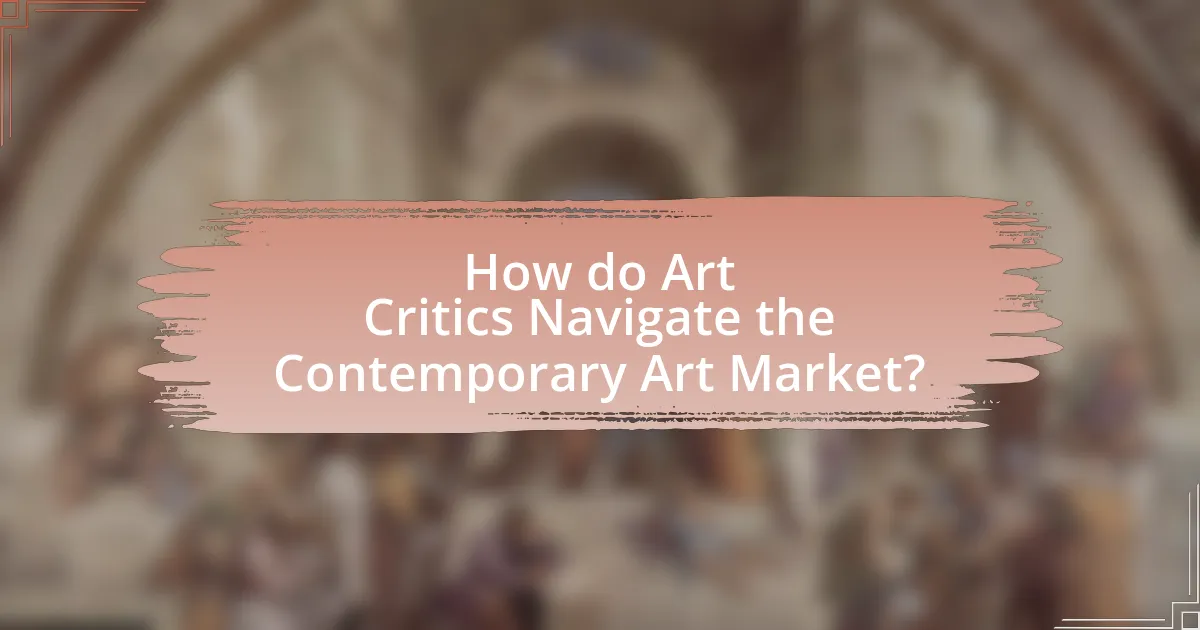
How do Art Critics Navigate the Contemporary Art Market?
Art critics navigate the contemporary art market by analyzing trends, evaluating artistic merit, and influencing public perception. They assess artworks based on criteria such as originality, technique, and cultural relevance, which helps collectors and institutions make informed decisions. For instance, critics often highlight emerging artists, shaping market demand and guiding investment. Their reviews can significantly impact an artist’s career trajectory, as seen in the case of artists like Jeff Koons, whose market value surged following critical acclaim. Additionally, critics participate in exhibitions and panels, further establishing their authority and insights within the market.
What role do art critics play in shaping market trends?
Art critics play a significant role in shaping market trends by influencing public perception and demand for artworks. Their reviews and analyses can elevate an artist’s profile, leading to increased interest and higher prices in the market. For example, when a critic praises a particular artist or exhibition, it often results in heightened visibility and can drive collectors to invest in that artist’s work, as seen in the case of artists like Jeff Koons and Damien Hirst, whose market values surged following critical acclaim. Additionally, art critics often set the narrative around emerging trends, guiding collectors and investors on what is considered valuable or noteworthy in the contemporary art scene.
How do critics identify emerging artists and movements?
Critics identify emerging artists and movements through a combination of observation, analysis of trends, and engagement with the art community. They closely monitor exhibitions, art fairs, and online platforms to spot innovative practices and unique voices that resonate with contemporary themes. For instance, critics often reference the rise of social media as a significant factor in discovering new talent, as platforms like Instagram allow artists to showcase their work directly to a global audience. Additionally, critics analyze the thematic relevance and technical execution of artworks, often citing specific examples from recent exhibitions to support their evaluations. This methodical approach enables critics to discern which artists and movements are gaining traction and may influence the future of the art market.
What factors do critics consider when assessing market potential?
Critics assess market potential by evaluating factors such as artist reputation, historical sales data, current market trends, and the uniqueness of the artwork. Artist reputation significantly influences perceived value; established artists often command higher prices due to their track record. Historical sales data provides insights into past performance, indicating demand and pricing patterns. Current market trends, including shifts in collector preferences and economic conditions, also play a crucial role in determining market viability. Lastly, the uniqueness of the artwork, including its originality and conceptual depth, can enhance its desirability and potential for appreciation in value.
How do art critics collaborate with galleries and institutions?
Art critics collaborate with galleries and institutions by providing expert evaluations and insights that enhance exhibitions and promote artists. This collaboration often involves critics writing reviews, participating in panel discussions, and advising on curatorial decisions, which can significantly influence public perception and attendance. For instance, a positive review from a respected critic can lead to increased visibility for an exhibition, thereby attracting more visitors and potential buyers. Additionally, critics may engage in collaborative projects, such as curated shows, where their expertise helps shape the narrative and thematic focus of the exhibition, ultimately benefiting both the gallery and the artists involved.
What is the significance of critic-led exhibitions?
Critic-led exhibitions are significant because they provide a platform for curatorial authority and critical discourse, shaping public perception and understanding of contemporary art. These exhibitions often reflect the critic’s expertise and vision, influencing trends and highlighting underrepresented artists or movements. For instance, the 2017 exhibition “The Future of the Past” at the Museum of Modern Art, curated by renowned critic and curator Hans Ulrich Obrist, showcased how critics can frame narratives that challenge conventional art histories and promote dialogue around cultural relevance. This role enhances the visibility of certain artworks and artists, ultimately impacting market dynamics and audience engagement in the contemporary art scene.
How do critics influence gallery programming and artist selection?
Critics significantly influence gallery programming and artist selection by shaping public perception and providing validation for artists. Their reviews and critiques can elevate an artist’s profile, leading galleries to prioritize those artists in exhibitions. For instance, a positive review in a prominent publication can result in increased visibility and demand for an artist, prompting galleries to include them in their programming. Additionally, critics often serve as gatekeepers, guiding galleries toward emerging trends and artists that align with current market interests, thus impacting the overall direction of contemporary art.
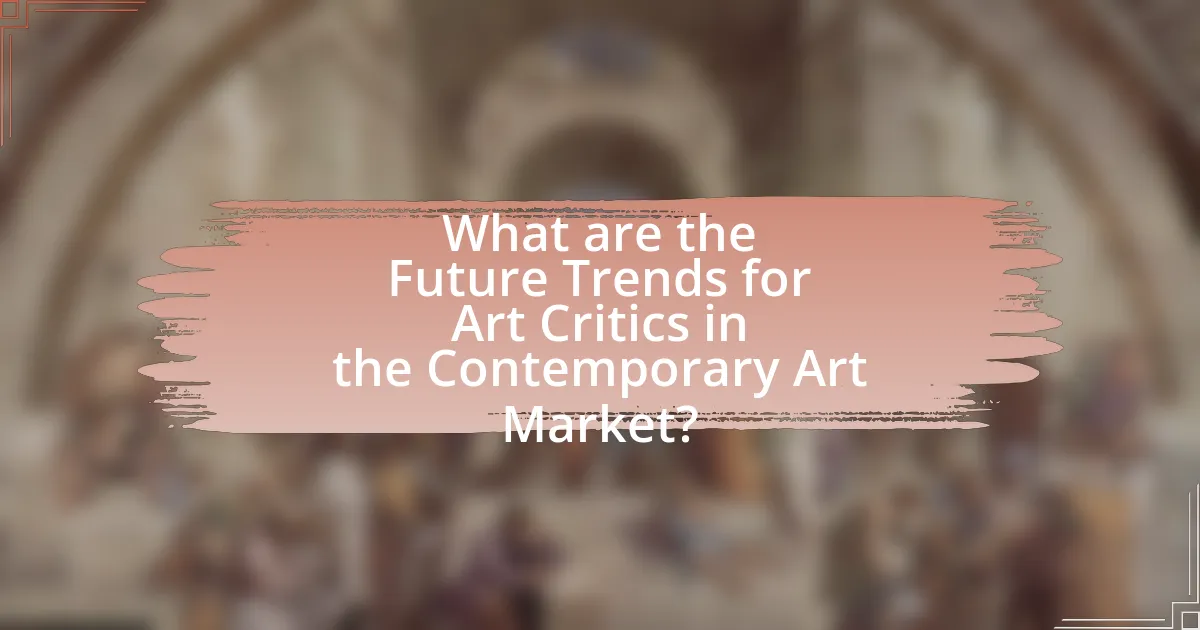
What are the Future Trends for Art Critics in the Contemporary Art Market?
Future trends for art critics in the contemporary art market include increased reliance on digital platforms and social media for critique dissemination, as well as a growing emphasis on inclusivity and diversity in art evaluation. As the art market evolves, critics are adapting by utilizing online channels to reach broader audiences, evidenced by the rise of art blogs and social media influencers who shape public perception. Additionally, the demand for diverse perspectives is prompting critics to engage with underrepresented artists and communities, reflecting a shift towards a more inclusive art discourse. This trend is supported by initiatives such as the “Diversity in Arts Leadership” program, which aims to foster a more equitable representation in the arts.
How is technology changing the role of art critics?
Technology is transforming the role of art critics by enabling them to access and analyze vast amounts of information quickly and efficiently. Digital platforms allow critics to share their insights instantly with a global audience, increasing their influence and reach. For instance, social media and online publications have democratized art criticism, allowing diverse voices to emerge and challenge traditional narratives. Additionally, data analytics tools help critics assess trends and audience preferences, enhancing their ability to provide informed critiques. This shift reflects a broader trend in the contemporary art market, where technology plays a crucial role in shaping discourse and engagement.
What new platforms are emerging for art criticism?
New platforms emerging for art criticism include online publications, social media channels, and digital art marketplaces. These platforms, such as Artsy, Hyperallergic, and Instagram, allow critics to reach wider audiences and engage with diverse art communities. For instance, Artsy combines art sales with editorial content, providing a space for critics to publish reviews alongside artworks. Hyperallergic offers a platform for independent voices in art criticism, emphasizing accessibility and inclusivity. Social media, particularly Instagram, has transformed how critics share insights and interact with artists and audiences in real-time, fostering a more dynamic dialogue around contemporary art.
How can art critics adapt to the digital landscape?
Art critics can adapt to the digital landscape by embracing online platforms for critique and engagement. This includes utilizing social media, blogs, and digital publications to reach wider audiences and foster discussions about art. For instance, a study by the Pew Research Center in 2021 found that 72% of adults in the U.S. use social media, highlighting the potential for critics to connect with diverse viewers. Additionally, critics can leverage multimedia tools, such as video reviews and virtual exhibitions, to enhance their analyses and make art more accessible. By integrating these digital strategies, art critics can remain relevant and influential in the evolving contemporary art market.
What skills will be essential for future art critics?
Future art critics will need strong analytical skills, effective communication abilities, and a deep understanding of contemporary art trends. Analytical skills enable critics to evaluate artworks critically, considering elements such as technique, context, and cultural significance. Effective communication is essential for articulating insights and critiques clearly to diverse audiences, whether through written reviews or public discussions. A deep understanding of contemporary art trends allows critics to contextualize their evaluations within the current art market and societal influences, ensuring their critiques remain relevant and informed. These skills are vital for navigating the complexities of the evolving art landscape and engaging with both artists and audiences effectively.
How can art critics enhance their credibility and authority?
Art critics can enhance their credibility and authority by consistently demonstrating expertise through in-depth knowledge of art history, theory, and contemporary practices. This expertise can be established by engaging in formal education, attending art exhibitions, and participating in relevant discussions within the art community. Additionally, publishing well-researched articles and critiques in reputable art journals or platforms can further solidify their standing. For instance, critics who have contributed to established publications like Artforum or The Art Newspaper are often viewed as more credible due to the rigorous editorial standards of these outlets. Furthermore, building a strong professional network with artists, curators, and other critics can enhance their visibility and influence in the art market.
What practical tips can aspiring art critics follow to succeed?
Aspiring art critics can succeed by developing a strong understanding of art history and contemporary trends. This foundational knowledge allows critics to contextualize artworks within broader movements and discussions, enhancing their credibility. Engaging with a diverse range of art forms and attending exhibitions regularly helps critics build a well-rounded perspective. Additionally, honing writing skills is crucial; clear, articulate, and insightful reviews attract readership and establish authority. Networking with artists, curators, and other critics fosters relationships that can lead to collaborative opportunities and increased visibility in the art community. Finally, maintaining an active online presence through blogs or social media platforms can amplify their voice and reach a wider audience, essential in today’s digital landscape.
